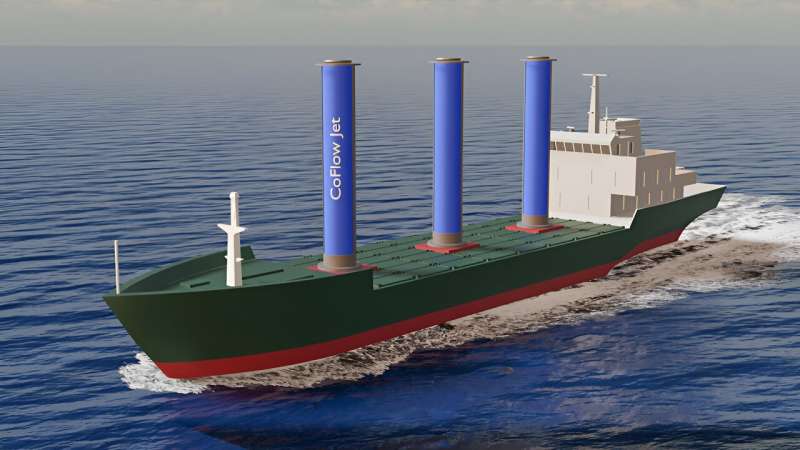This article has been reviewed according to Science X's editorial process and policies. Editors have highlighted the following attributes while ensuring the content's credibility:
fact-checked
trusted source
proofread
'Windfall' technology to power cargo ships

With their massive sails stretched over towering masts, merchant ships that plied the world's oceans hundreds of years ago helped launch the era of commercial shipping, delivering goods of all kinds to different ports of call.
Those early cargo ships would eventually give way to diesel-powered vessels. But along with the change in thrust came greenhouse gas emissions harmful to the planet.
Now, a University of Miami College of Engineering researcher wants to help today's massive and modern cargo ships go green—and his strategy is to employ an age-old method of propulsion: wind.
"What's old is new again," said GeCheng Zha, a professor of aerospace engineering and director of the Aerodynamics and Computational Fluid Dynamics Lab.
"With the technological advancements of today, wind-assisted propulsion is an efficient alternative to diesel engines. And the major advantage is that it's environmentally friendly—an effective way to decarbonize the shipping industry that's responsible for about 3% of global greenhouse gas emissions."
Zha is developing giant cylinders that would be mounted on the decks of cargo ships, generating thrust by sucking in, pressurizing, and ejecting air in a different direction.
Several stories high, each cylinder could be lowered, allowing ships to pass beneath bridges and to navigate in and out of ports.
On some shipping routes, the cylinders could cut fuel consumption by as much as 50%, according to Zha, who is still in the design and simulation phase for his wind-propulsion instruments.
His research couldn't be timelier. Last year, the International Maritime Organization, a United Nations specialized agency responsible for regulating maritime transport, announced a revised strategy that requires the international shipping industry to achieve net-zero greenhouse gas emissions "by or around" 2050.
"The shipping industry has had a tendency to resist change because diesel engines are so powerful," Zha said. "But now, with pressure mounting, either willingly or unwillingly, it will have to change."
His high-tech cylinders represent a growing movement in the shipping industry to develop and employ wind-assisted technologies to make cargo ships greener. From spinning rotors that use the so-called Magnus force to convert wind energy into propulsive force to nonrotating suction wings that use vents and internal fans to achieve propulsion, the technology to power cargo ships with an age-old concept is gaining steam.
The technology is already in use on some vessels. About 30 cargo ships out of a global fleet of roughly 60,000 are currently using wind propulsion, deploying rigid sails made of aluminum, fiberglass, and carbon fiber that operate under minimum power from a ship's engines. That number is expected to increase to nearly 11,000 by the end of this decade, according to the London-based International Windship Association.
Zha's nonrotating cylinders, developed with co-flow jet technology similar to what he employed for his ongoing research on new types of aircraft, would be "much more efficient" than wind-assisted propulsion units that are currently in use on the few cargo ships that have them, he said. "We would be capable of achieving greater thrust," he explained.
Now, the only challenge that remains for Zha is securing funding to develop a prototype. "We'll get there," he said. "With about 90% of the world's trade traveling by ship, this technology is a 'windfall' of an idea."


















